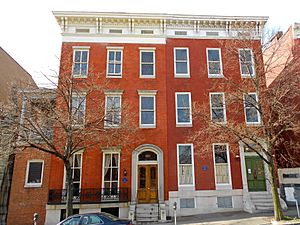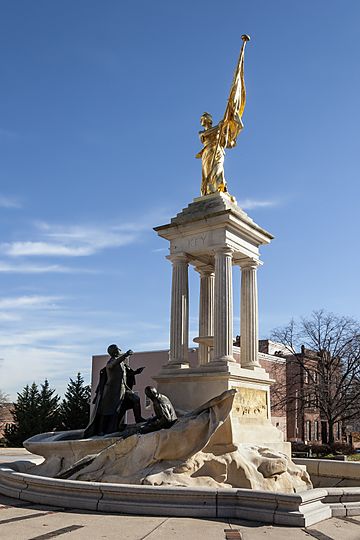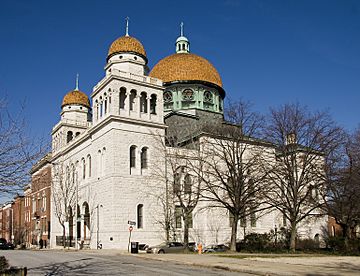Bolton Hill, Baltimore facts for kids
Quick facts for kids
Bolton Hill
|
|
|---|---|
|
Neighborhood of Baltimore
|
|
 |
|
| Country | United States |
| State | Maryland |
| City | Baltimore |
| District | Central |
| Settled | 1850 |
| Founded by | George Grundy |
| Named for | Bolton le Moors |
|
Bolton Hill Historic District
|
|
| Lua error in Module:Location_map at line 420: attempt to index field 'wikibase' (a nil value). | |
| Location | Baltimore, Maryland |
| Architect | Multiple |
| Architectural style | Late Victorian, Late 19th And 20th Century Revivals |
| NRHP reference No. | 71001031 |
| Added to NRHP | September 17, 1971 |
Bolton Hill is a neighborhood in Baltimore, Maryland. It has many well-kept buildings from the late 1800s. This area is a special historic place, protected to keep its old charm. It is part of the National Register of Historic Places.
Bolton Hill is located between North Avenue, Mount Royal Avenue, Cathedral Street, Dolphin Street, and Eutaw Place. You'll find many three-story houses made of red brick with white marble steps. These homes often have high ceilings. There are also larger, more fancy houses, many places of worship, parks, and monuments. A few big apartment buildings are here too. Many famous people have lived in Bolton Hill, like author F. Scott Fitzgerald and former President Woodrow Wilson.
The neighborhood is easy to get to. You can walk to the State Center station on the Baltimore Metro Subway. The Mt. Royal/MICA station on the Baltimore Light Rail is also nearby.
Contents
Who Lives in Bolton Hill?
In 2010, about 4,974 people lived in Bolton Hill. Most residents were White (56.4%) or African American (31.8%). About 7.3% were Asian. Most homes (65.8%) were rented, while 24% were owned by the people living in them.
The Story of Bolton Hill
How Bolton Hill Got Its Name
Bolton Hill is named after the large estate of George Grundy. He named his estate after a place called Bolton le Moors. This estate was where the Fifth Regiment Armory stands today.
Early Development and Growth
In 1832, the Northern Central Railroad built Bolton Station here. This was the end of the train line until 1850. Around 1850, the area started to change. Large estates became neighborhoods with traditional Baltimore row houses. These houses were built along a special street plan. This plan was different from the usual straight north-south streets in Baltimore.
The first row houses had plain brick fronts. They had pretty decorations around the doors and windows. Later, houses were built with more detailed designs. Building row houses continued until the late 1800s. A few large apartment buildings were added in the early 1900s.
A Diverse Community
Unlike some other rich neighborhoods in Baltimore back then, Bolton Hill was quite diverse. It welcomed people from different backgrounds. Even though society was often separated, many African-American servants lived in smaller alley houses. These servants worked for the wealthy families in Bolton Hill.
At the end of the 1800s, many German Jewish families moved to Bolton Hill. Several synagogues moved nearby. Two large temples were also built right in Bolton Hill. The Eutaw Place Temple was built in 1892. The Har Sinai Congregation built a large temple in 1894. This is now the oldest Reform Jewish group in the United States.
Changes Over Time
In the early 1900s, some white residents worried about the growing African-American community nearby. This led to many white families moving away. A group called the Mount Royal Improvement Association (MRIA) was formed in 1928. This group tried to keep African-Americans from living in the neighborhood. They even said Bolton Hill was a "protected area" for white people only.
By the mid-1900s, many Bolton Hill residents moved to the suburbs. They wanted modern homes with yards. In the early 1960s, most Jewish groups also moved to the northwest suburbs.
Protecting History
In the early 1960s, some older houses on the western edge of Bolton Hill were torn down. This was part of a city plan to improve the area. New buildings were put in their place.
In 1967, Bolton Hill became a special historic district for Baltimore City. In 1971, it was added to the National Register of Historic Places. This helped protect most of the neighborhood's old buildings.
In 2018, the community group changed its name to the Bolton Hill Community Association. This was to show they no longer supported their old rules about who could live there. They wanted to be more welcoming to everyone.
Bolton Hill has even been featured on TV! Starting in 2012, the popular Netflix show House of Cards filmed scenes here. They used a Bolton Hill home to look like the main characters' house in Washington, D.C.
Famous People from Bolton Hill
Many interesting people have lived in Bolton Hill:
- James M. Cain: An author who wrote The Postman Always Rings Twice.
- Lillie Mae Carroll Jackson: A leader in the Civil rights movement.
- Claribel and Etta Cone: These sisters were famous art collectors. They helped artists like Pablo Picasso and Henri Matisse. They also gave many artworks to the Baltimore Museum of Art.
- F. Scott Fitzgerald: A well-known American author. He wrote Tender is the Night while living in Bolton Hill from 1933 to 1935.
- Leon Fleisher: A talented pianist and conductor.
- Daniel Coit Gilman: The first president of Johns Hopkins University. He was also the first director of Johns Hopkins Hospital.
- Edith Hamilton: A writer who studied ancient Greece and Rome. She was the first Headmistress of the Bryn Mawr School.
- Alice Hamilton: A leading expert in workplace health. She was Harvard's first female professor.
- Chris Keating (musician): The lead singer of the rock band Yeasayer.
- Charles Marshall: A high-ranking officer for General Robert E. Lee during the Civil War.
- Garry Moore: A popular television host for many years.
- Curt Richter: A biologist and geneticist at Johns Hopkins University.
- Louis Rukeyser: The host of the long-running PBS show about business, "Wall Street Week With Louis Rukeyser."
- Florence Rena Sabin: A pioneering medical researcher. She was the first woman to be a full professor at Johns Hopkins School of Medicine. She was also the first woman elected to the National Academy of Sciences.
- Gertrude Stein: A famous writer who influenced many artists.
- Woodrow Wilson: A former President of the United States. He lived in Bolton Hill while studying at Johns Hopkins.
Images for kids
-
The historic Eutaw Place Temple.






